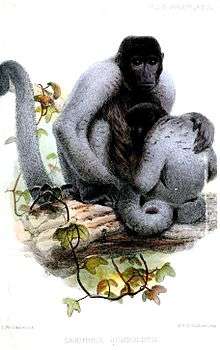Woolly monkey
| Woolly monkeys[1] | |
|---|---|
 | |
| L. lagotricha | |
| Scientific classification | |
| Kingdom: | Animalia |
| Phylum: | Chordata |
| Class: | Mammalia |
| Order: | Primates |
| Family: | Atelidae |
| Subfamily: | Atelinae |
| Genus: | Lagothrix É. Geoffroy, 1812 |
| Type species | |
| Simia lagotricha Humboldt, 1812 | |
| Species | |
|
Lagothrix lagotricha | |
The woolly monkeys are the genus Lagothrix of New World monkeys, usually placed in the family Atelidae.
The four species of woolly monkey all originate from the rainforests of South America. They have prehensile tails and live in relatively large social groups.
One species of woolly monkey, the yellow-tailed woolly monkey, has recently been placed in the genus Oreonax.
Anatomy
Woolly monkeys have coat colour variations including dark brown, red-brown, gray and olive. Their back sides are usually lighter in color than their under-belly sides. They have black faces, and the palms of their hands are a deep pink color. Their tails are long and thick and a strong enough to support the animals' full body weight. The species has a prehensile tail which grips on tight to branches, acting as a fifth limb and enabling the animal to forage while hanging on to a branch with its tail. Woolly monkeys weigh an average of 17 lb (7.7 kg), though males are substantially larger than females.
Habitat and social behaviour
Woolly monkeys are found throughout the northern countries of South America (Bolivia, Brazil, Colombia, Ecuador, Venezuela and Peru). They usually reside in high-elevation cloud forests, seasonally flooded rainforests and forests which are situated within Colombia's eastern plains region, although their ideal habitat is humid and mature tropical forests.
The species lives in social groups ranging from 10 to 45 individuals. Foraging groups, however, tend to consist of two to six individuals which branch out from the main group, which is probably intended to reduce food competition between individuals. Woolly monkey diets consist of fruit with an addition of leaves, seeds, flowers and invertebrates. Each group is governed and led by an alpha male, and the social organization within a larger group is organized by age, sex, and the reproductive status of females. Reproduction in these groups is characterized by promiscuity; one male (either the alpha or subordinate) will mate with more than one female, just as females will mate with more than one male. Shortly after the females reach maturity, they leave their natal (birth) groups to avoid any occurrence of inbreeding, while males tend to remain in their natal groups.
Play sessions among individuals not only serves as a bonding process to rekindle relationships among individuals, but is also a way the species establishes a hierarchy or social pecking order, as well as passive food sharing, which is also considered a common routine in the species. Woolly monkeys have an elaborate system of vocalization and olfactory, visual and tactile communication. These can be used to coordinate group activities, indicate aggression, affection and marking, and establish territories.
Predation and preservation
Woolly monkeys are hunted by a variety of species of eagles and cats, such as the jaguar. Its main predator, however, is humans, who hunt the species both for nutrition and for the illegal pet trade. Habitat encroachment is also threatening the survival of the species; all these factors are believed to be the cause of the species' recent decline. Woolly monkeys are now considered highly endangered, and captive individuals are bred to ensure the survival of the species as part of the International Breeding Program for Endangered Species.
Species list
- Brown woolly monkey, Lagothrix lagotricha
- Gray woolly monkey, Lagothrix cana
- L. c. cana
- L. c. tschudii
- Colombian woolly monkey, Lagothrix lugens
- Silvery woolly monkey, Lagothrix poeppigii
Further reading
- Thomas R. Defler & Pablo R. Stevenson (eds.): The Woolly Monkey: Behavior, Ecology, Systematics, and Captive Research. Springer, New York 2014. ISBN 978-1-4939-0696-3 (print); ISBN 978-1-4939-0697-0 (eBook)
References
- ↑ Groves, C.P. (2005). Wilson, D.E.; Reeder, D.M., eds. Mammal Species of the World: A Taxonomic and Geographic Reference (3rd ed.). Baltimore: Johns Hopkins University Press. pp. 151–152. OCLC 62265494. ISBN 0-801-88221-4.
External links
| Wikispecies has information related to: Woolly monkey |
| ||||||||||||||||||||||||||||||||